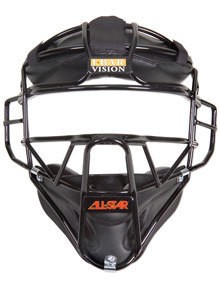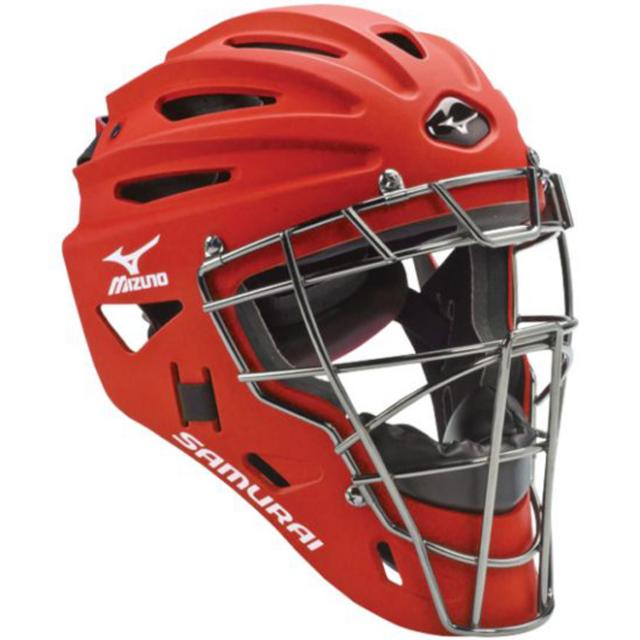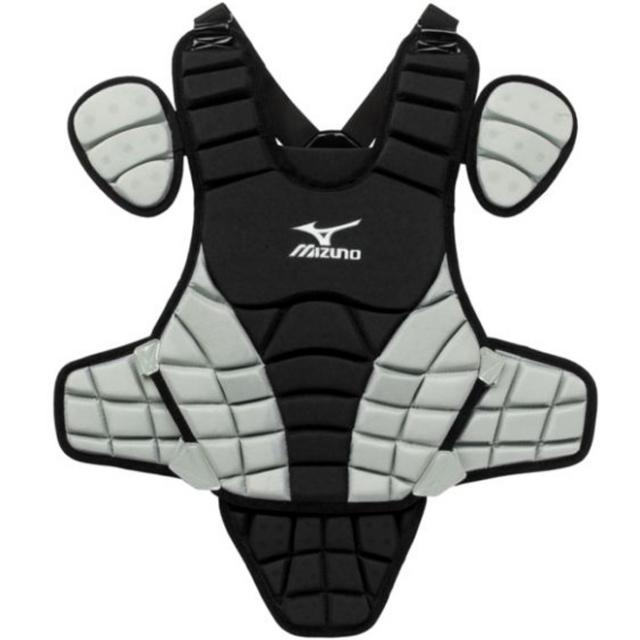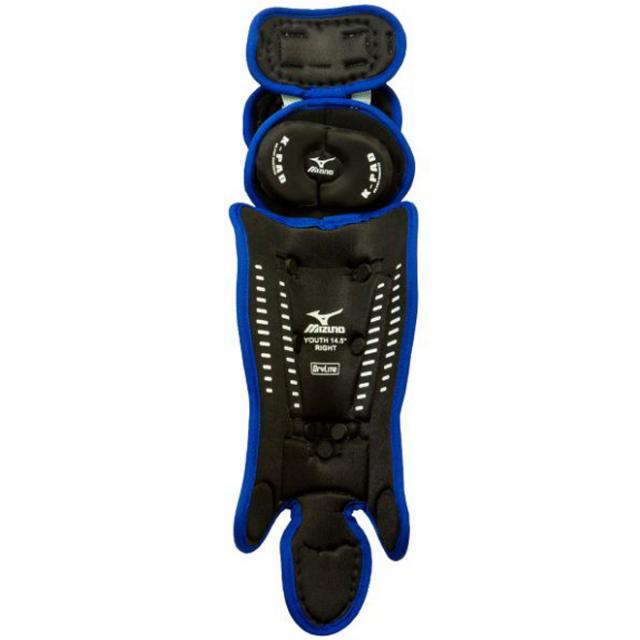There's a reason baseball catcher's gear has long been referred to as "tools of ignorance." It's because most parents and players know little about a catcher's armor, what it's for, and what it does!
Unfortunately, though, with tons of brands, designs, styles, sizes, and price points, and new technologies developed every season, it's pretty easy to get lost. So here's some information and a bit of wisdom on the topic to help new baseball parents become less ignorant of the tools of ignorance.
Thankfully, there are really only three main pieces of equipment your new baseball catcher needs to wear to stay safe behind the plate: (1) a catcher's mask or catcher's helmet; (2) a chest protector; and (3) shin guards.
The mask
Let's start at the top. To protect their head from foul balls, wild pitches and wild swings, catchers wear of two types of masks these days: the classic 2-piece mask, which catcher's have been wearing since the 1800's, and the modern hockey-style catcher's helmet, which you've probably seen on pro catchers like Buster Posey. Most youth baseball leagues mandate the use of hockey-st yle helmets, but it's important to understand the difference between the two, and decide what's best for your child, if they let you:
yle helmets, but it's important to understand the difference between the two, and decide what's best for your child, if they let you:
- The classic catcher's mask is a simple face mask with padding on the forehead and around the jaw area. Players wear it with a batting helmet turned backwards, for complete facial and cranial protection. Many seasoned pro catchers like this style, since they can quickly pull off the mask to track a fly foul ball, but it only provides moderate coverage and protection to the head and face.
- Hockey-style catcher's helmets resemble those used by hockey goalies (thus the name), and deliver full cranial coverage, protecting the front, top, and sides of the head, with a solid shell, face-mask, and thick internal padding. They also extend down passed the jaw, providing some neck and throat coverage. Because of their built though, helmets tend to restrict peripheral visibility a bit, and can be difficult to remove quickly.
For younger players, a hockey-style helmet is definitely the way to go. The reduced visibility and mobility are small prices to pay for the added protection, especially with the heightened awareness of concussions these days. Price-wise, quality catcher's helmets can cost anywhere from $25 to over $200. Typically, the more  expensive the helmet, the more advanced, lightweight, breathable, moisture wicking, and impact absorbing the inner padding, and the more durable and vented the outer shell and face-mask will be.
expensive the helmet, the more advanced, lightweight, breathable, moisture wicking, and impact absorbing the inner padding, and the more durable and vented the outer shell and face-mask will be.
For serious youth catchers, a top-of-the-line helmet can really improve their game. But for newer catchers, these technologies and design features may be a little superfluous. Generally speaking, look for a baseball catcher's helmet with ample internal padding around the forehead, jaw, and temples, ventilation holes in the shell, and a strong face-mask that protects the face without obscuring visibility.
Chest protectors
Chest protectors are needed to cover the torso and protect the body from foul balls, wild pitches, missed catches, and hard collisions at the plate. Without this sheet of padded armor, impacts like these could really cause a lot of damage, and the last thing either you or your child need are baseball-sized bruises and broken ribs. That's why it's important to know what you're getting with a new chest protector.
Most tend to look the same - contoured padding that fits over the body and secures with straps on the back - but in that simple design, there are hundreds of variations, both in form and price. For the most part, quality chest protectors range from about $60 to $100, although top-of-the-line chest protectors can run up to $200 and beyond. 
The major factors in pricing chest protectors are the form, technology, and type of padding. Expensive chest protectors are conformed to hug the natural curves of the body for better-fitting protection. The foam padding is also lighter, more impact-absorbing, and may be enhanced to deaden the baseball upon impact, making it easier to field when it hits the chest after a missed pitch. Whatever your budget, your young catcher should have a chest protector that offers detachable wings and shoulder pads, which extend the reach of the protector around the crotch, hips, and shoulders. It's also a good idea to find a chest protector with a moisture wicking and breathable liner, so they'll stay cool and comfortable behind the plate.
Shin guards
Shin guards protect knees, shins, legs, and ankles from missed pitches, impacts at the plate, and abrasions when a catcher drops down to the dirt to block a wild pitch. They can range from around $40 to almost $200, based on the quality of the inner padding and  cushioning, the durability of the buckles and outer shell, the contouring of the knee caps, technologies built in, and extra features, like foot protection. Higher-end shin guards use lightweight, moisture wicking, breathable, and impact absorbing inner padding, as well as strong, durable, and matte-finished shells for added comfort, protection, and a snug, secure fit. You'll find that shin guards are also typically built with either double or triple knee caps. Triple knee caps fold over each other, offering more coverage to the knee when in the crouch position than double knees. But for the average catcher or those new to the game, you should look for comfortable shin guards that wrap around the leg, for inner shin protection, and feature at least a double knee cap. It may also be beneficial to find a set with added foot and ankle protection.
cushioning, the durability of the buckles and outer shell, the contouring of the knee caps, technologies built in, and extra features, like foot protection. Higher-end shin guards use lightweight, moisture wicking, breathable, and impact absorbing inner padding, as well as strong, durable, and matte-finished shells for added comfort, protection, and a snug, secure fit. You'll find that shin guards are also typically built with either double or triple knee caps. Triple knee caps fold over each other, offering more coverage to the knee when in the crouch position than double knees. But for the average catcher or those new to the game, you should look for comfortable shin guards that wrap around the leg, for inner shin protection, and feature at least a double knee cap. It may also be beneficial to find a set with added foot and ankle protection.
Correct fit is key
Almost as important as choosing budget- and skill-appropriate equipment, is buying correctly sized catcher's gear. Even expensive baseball catcher's gear can't do its job if it doesn't fit correctly and cover everything it needs to cover, so when finding new equipment, make sure you know what sizes you need:
- Catcher's masks and helmets typically come in three sizes: youth, intermediate, or adult, and are adjustable with a moveable back plate, so as long as you find a helmet in their age range, the helmet should fit snugly when adjusted.
- Chest protectors range from 11" to 18", and to find your child's size, simply use a tape measure, and measure the length from the bottom of their throat to the naval.
- Shin guards tend to range from 11" to 17", and you can use the same tape measure to measure from the middle of the knee to the top of the foot to find their size.
A tip for parents of a new catcher: Many retailers and brands like Mizuno, Nike, and Under Armour package their helmets, chest protectors, and shin guards into catcher's sets. For a new catcher and new baseball parents, these full sets are great options! They come with everything your child needs to play safely, and take a lot of the guess work out of finding three separate pieces. They also cost less than purchasing each piece individually.
So now that you know about catcher's gear, its time to for your child to play safe, play smart, and have fun this season!
Brandon Porter works for Sports Unlimited, Inc., a family owned, full-line Internet-based sporting goods store in Hatfield, Pennsylvania.
Posted February 24, 2012








